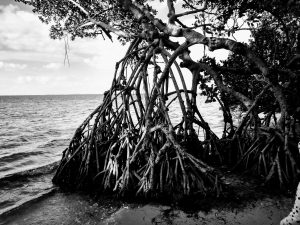
Mangroves
Mangrove trees are an important part of Florida’s diverse ecosystem and are integral to the coastal estuaries where they grow. Mangrove forests in the tropics and subtropics are identifiable by their dense tangle of prop roots that help the trees handle the rise and fall of the tides. These roots act as a net, holding and stabilizing shorelines. In addition, these roots provide shelter to the majority of all recreationally and commercially important fish species in Florida. Their unique structure makes them able to withstand major storm forces like those from hurricanes. Mangroves are a keystone species providing essential services that act as the base for the entire estuarine community. Occasionally referred to as the kidneys of the coast, mangroves are magnificent filters and maintain necessary water clarity for offshore corals and near shore seagrasses.
In fact, mangroves are so essential to the coastal ecosystem that laws have been passed to protect these trees. The 1996 Mangrove Trimming and Preservation Act prohibits trimming or alteration of mangroves on publicly-owned lands and sets specific limits for trimming or removal of mangroves on private property. Depending on the site conditions, a permit may be needed to trim or remove dead or living parts of a mangrove tree. Contacting a certified mangrove trimmer will help you adhere to the law, or you can contact the Florida Department of Environmental Protection (FLDEP). Certified mangrove trimmers are individuals that hold one of the following certifications; certified arborist, professional wetland scientist, professional landscape architect, certified environmental professional and certified ecologist. Some counties and municipalities have received delegation of the state rule, allowing them to administer the rule on behalf of the FLDEP. Check this list to determine if your area is under local delegation.
Homeowners Should Know
Some activities related to mangrove trimming fall under a homeowner exemption. These activities may include; maintaining an existing mangrove hedge or trimming branches blocking walkways on docks (without defoliating or damaging the plant). In any case, in order for a homeowner to trim without a certified mangrove trimmer, the following criteria must apply:
- Property Shoreline length of 150 ft. or less
- Initial mangrove height between 6 ft. and 10 ft.
- Depth of mangrove fringe 50 ft. or less
See this document from the FLDEP regarding trimming requirements.
Mangrove Identification
Out of the approximately seventy species of mangroves that are classified in the world, three live in Florida. These three species are from distinct genera, since ‘mangrove’ is often a term used to describe both an ecosystem and a type of plant. The three native mangrove trees found in Florida are black mangrove, white mangrove, and red mangrove. Two non-native species can be found growing in South Florida, large leaf mangrove (Bruguiera gymnorhiza) and Asian black mangrove (Lumnitzera racemosa).
Red Mangrove (Rhizophora mangle)
These are the mangroves people often envision when they think of mangroves, they have prop roots and long, dangling pencil-like propagules. They are generally found in standing water in Zones 10 and 11. These mangroves have a lower soil salt tolerance than other mangroves and therefore tend to inhabit lower portions of regularly flooded intertidal zones. Red mangroves are occasionally called the ‘walking trees’ due to their horizontal growth habit. Red mangroves reach between 20 and 75 feet tall. The national champion red mangrove is in Lee County Florida, documented at 64 feet tall.
https://edis.ifas.ufl.edu/pdffiles/FP/FP50200.pdf
Black Mangrove (Avicennia germinans)
These trees grow in Zones 8b to 11b and reach heights of 40 to 60 feet tall. This evergreen tree generally grows further inland than reds, where the roots are still inundated during high tide. Black mangroves have a higher salt tolerance than the other two species. Black mangrove trees have glands on their leaf surfaces that excrete excess salt, indigenous people gathered the leaves for this salt. Historically, the wood was an important fuel source for smoking fish. The bark was also used in the tanning process as a black dye for animal skins. Additionally, the flowers are a popular nectar source for honey bees, leading to the creation of ‘mangrove honey’.
http://edis.ifas.ufl.edu/pdffiles/FR/FR32100.pdf
White Mangrove (Laguncularia racemosa)
More of an upland species of mangrove, white mangroves are generally found further inland along the coast where it is irregularly flooded in the intertidal zone. These trees grow in Zones 9a to 11b and reach 30 to 40 feet tall. White mangrove trees produce hard, strong wood that has historically been used for lumber. Most commonly these trees were used as a fuel source and for tanning leather.
http://edis.ifas.ufl.edu/pdffiles/FR/FR32500.pdf
Materials modified with permission from Gardening Solutions: http://gardeningsolutions.ifas.ufl.edu/plants/trees-and-shrubs/trees/mangroves.html
 0
0
